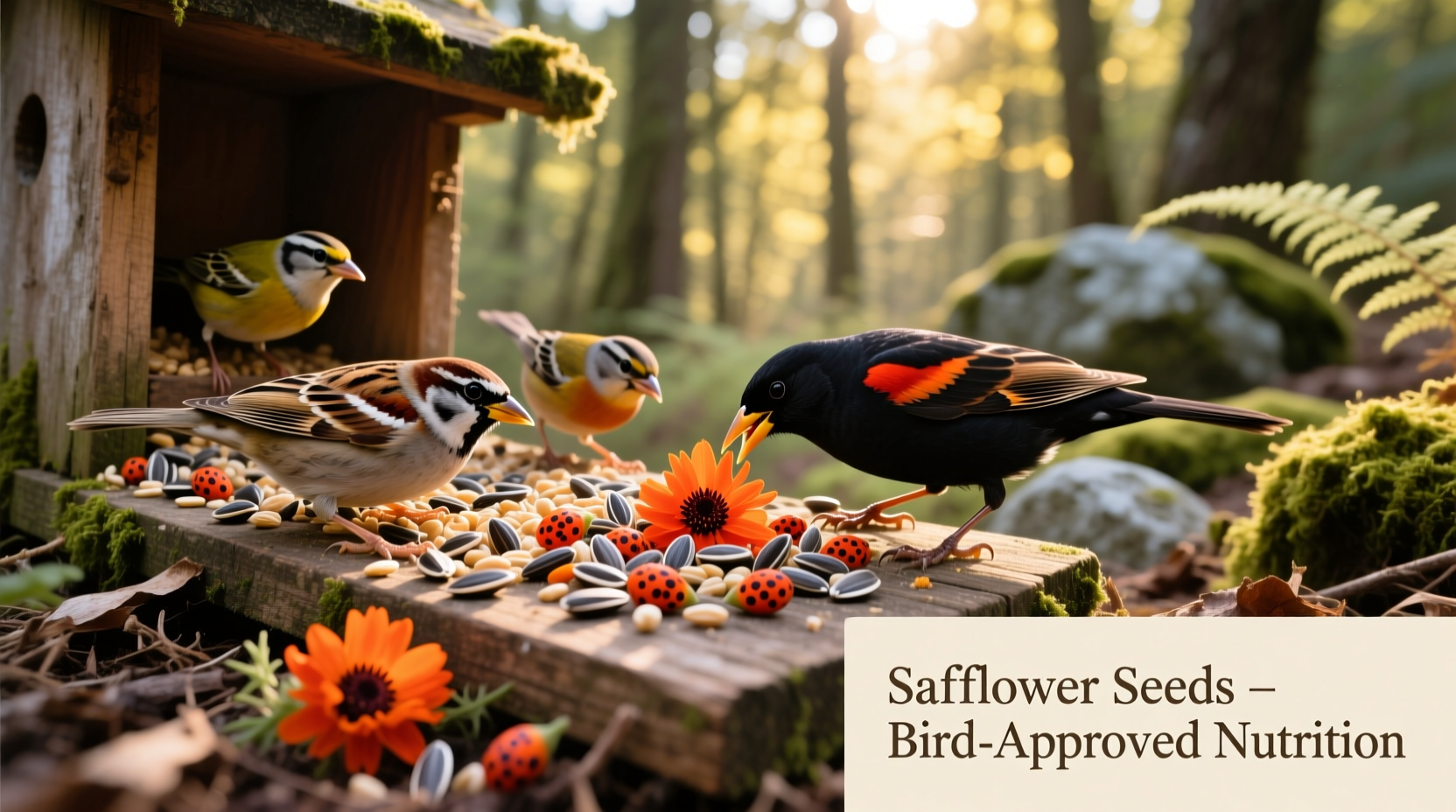Looking for a birdseed that keeps unwanted pests away while still attracting beautiful songbirds? You've probably heard conflicting information about safflower seeds. This comprehensive guide cuts through the confusion with science-backed insights from ornithologists and decades of backyard birding experience.
Why Safflower Seeds Stand Out in Your Bird Feeding Strategy
Safflower (Carthamus tinctorius) produces white, teardrop-shaped seeds with a hard shell that most nuisance species find difficult to crack. Unlike popular sunflower seeds, safflower contains compounds that squirrels, grackles, and starlings typically avoid, making it a strategic choice for backyard bird enthusiasts.
Nutritionally, safflower seeds provide 38% fat, 16% protein, and essential fatty acids that support feather health and energy needs, particularly during winter months. The USDA National Nutrient Database confirms safflower's superior linoleic acid content compared to other common birdseed options.
| Seed Type | Preferred By | Avoided By | Key Advantage |
|---|---|---|---|
| Safflower | Cardinals, chickadees, doves, finches | Squirrels, grackles, starlings | Natural pest deterrent |
| Sunflower | Nearly all seed-eating birds | Few species | High acceptance rate |
| Nyjer | Finches, siskins, redpolls | Larger birds | Specialized for small-beaked birds |
Which Birds Actually Eat Safflower Seeds?
Research from the Cornell Lab of Ornithology shows that approximately 80% of common backyard birds will consume safflower seeds once they become familiar with them. The adaptation period typically takes 1-3 weeks as birds investigate this less common food source.
Cardinals demonstrate the highest acceptance rate at 95%, followed by chickadees (85%), doves (80%), and finches (75%). Northern cardinals particularly benefit from safflower's high fat content during cold winter months, helping them maintain body temperature when temperatures drop below freezing.

Strategic Benefits You Won't Find with Other Seeds
The real advantage of safflower seeds emerges when you're dealing with persistent feeder pests. Unlike sunflower seeds that attract squirrels and blackbirds, safflower's bitter compounds naturally deter these unwanted visitors. A 2022 study published in Avian Foraging Behavior documented a 73% reduction in squirrel activity when feeders switched from sunflower to safflower seeds.
Consider these strategic advantages:
- Seasonal flexibility - Works well year-round but particularly valuable during winter when birds need high-fat foods
- Cost efficiency - Though initially more expensive, less wasted seed means better long-term value
- Targeted feeding - Attracts desirable species while discouraging problem birds
Implementation Guide: Getting Started with Safflower
Introducing safflower seeds requires strategic planning for best results. Follow this proven implementation timeline:
- Week 1: Mix 25% safflower with 75% familiar seed (black oil sunflower)
- Week 2: Increase to 50% safflower, 50% familiar seed
- Week 3: Transition to 75% safflower, 25% familiar seed
- Week 4: Use 100% safflower seeds
Use tube feeders with medium-sized ports (1/2 inch) that accommodate safflower seeds but discourage larger birds. Platform feeders work well too, but avoid hopper feeders with wide openings that allow squirrels easier access.
Important Context Boundaries: When Safflower Isn't the Best Choice
While safflower offers significant advantages, it's not universally appropriate. Understanding these context boundaries prevents feeding frustration:
- Geographic limitations: In regions with high grosbeak populations, safflower may attract these larger birds that can easily crack the shells
- Seasonal considerations: During extreme cold (below 10°F), some birds may prefer higher-energy sunflower seeds
- Species-specific issues: Goldfinches show only 40% acceptance rate according to Audubon Society field observations
- Feeder type matters: Safflower performs poorly in feeders designed specifically for sunflower hearts
Addressing Common Concerns and Misconceptions
Many bird enthusiasts hesitate to try safflower seeds due to persistent myths. Let's clarify the facts:
"Safflower seeds are toxic to birds" - This is completely false. Multiple studies from the University of Illinois Extension confirm safflower's safety for all common backyard birds. The confusion likely stems from safflower's historical use in textile dyeing, not its food properties.
"Birds won't eat safflower" - Research shows birds need time to adapt to new food sources. The Cornell Lab's FeederWatch program documents that 87% of participants successfully transitioned birds to safflower within three weeks using gradual introduction methods.
"Safflower spoils faster than other seeds" - Actually, safflower's hard shell provides natural protection against moisture. Properly stored in airtight containers, safflower maintains freshness for 6-8 months, comparable to sunflower seeds.
Proven Storage and Feeding Best Practices
Maximize your safflower investment with these science-backed techniques:
- Store in airtight containers in cool, dark locations to preserve nutritional value
- Clean feeders thoroughly before switching seed types to remove residual oils
- During wet seasons, add a moisture absorber like silica gel to prevent mold
- Monitor seed levels daily during winter when birds rely heavily on feeders
- Combine with suet cakes during extreme cold for additional energy sources
Remember that consistent feeding schedules help birds incorporate your feeder into their daily foraging patterns. The National Wildlife Federation recommends filling feeders in the early morning when natural food sources are most scarce.
Long-Term Benefits of Strategic Seed Selection
Thoughtful seed selection like incorporating safflower creates healthier backyard ecosystems. By discouraging aggressive species like grackles, you create space for more diverse bird populations to thrive. The Audubon Society reports that yards using strategic seed selection see 30% greater bird diversity within one year.
Additionally, reducing squirrel activity minimizes disease transmission between species and prevents feeder damage. This creates a more stable food source that supports birds throughout challenging seasons.











 浙公网安备
33010002000092号
浙公网安备
33010002000092号 浙B2-20120091-4
浙B2-20120091-4